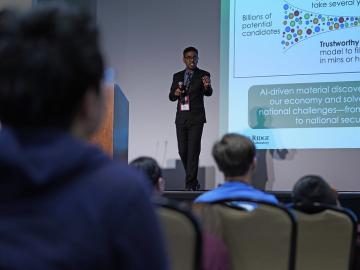
Filter News
Area of Research
News Topics
- (-) 3-D Printing/Advanced Manufacturing (11)
- (-) Artificial Intelligence (23)
- (-) Grid (6)
- (-) Materials Science (15)
- (-) Mercury (1)
- (-) Nuclear Energy (8)
- (-) Partnerships (11)
- (-) Physics (6)
- (-) Quantum Science (12)
- (-) Security (2)
- Advanced Reactors (3)
- Big Data (10)
- Bioenergy (12)
- Biology (12)
- Biomedical (5)
- Biotechnology (5)
- Buildings (13)
- Chemical Sciences (12)
- Clean Water (3)
- Climate Change (19)
- Composites (5)
- Computer Science (24)
- Critical Materials (3)
- Cybersecurity (2)
- Decarbonization (20)
- Education (1)
- Emergency (1)
- Energy Storage (9)
- Environment (22)
- Exascale Computing (6)
- Fossil Energy (2)
- Frontier (6)
- Fusion (6)
- High-Performance Computing (13)
- Isotopes (11)
- ITER (1)
- Machine Learning (8)
- Materials (13)
- Mathematics (2)
- Microelectronics (1)
- Microscopy (3)
- Nanotechnology (2)
- National Security (14)
- Net Zero (5)
- Neutron Science (12)
- Polymers (5)
- Quantum Computing (10)
- Simulation (12)
- Space Exploration (3)
- Statistics (2)
- Summit (4)
- Sustainable Energy (16)
- Transportation (14)
Media Contacts

ORNL researchers completed successful testing of a gallium nitride transistor for use in more accurate sensors operating near the core of a nuclear reactor. This is an important technical advance particularly for monitoring new, compact.

Researchers used quantum simulations to obtain new insights into the nature of neutrinos — the mysterious subatomic particles that abound throughout the universe — and their role in the deaths of massive stars.

In May, the Department of Energy’s Oak Ridge and Brookhaven national laboratories co-hosted the 15th annual International Particle Accelerator Conference, or IPAC, at the Music City Center in Nashville, Tennessee.
Close on the heels of its fourth summer school, the Quantum Science Center, or QSC, hosted its second in-person all-hands meeting in early May. More than 150 scientists, engineers and support staff traveled from 17 institutions to review the QSC’s progress, examine existing priorities and brainstorm new short- and long-term research endeavors.

An Oak Ridge National Laboratory team revealed how chemical species form in a highly reactive molten salt mixture of aluminum chloride and potassium chloride by unraveling vibrational signatures and observing ion exchanges.

Six firms received Small Business Awards from the Department of Energy’s Oak Ridge National Laboratory. The companies, selected from small business service providers to the lab, were recognized by ORNL's Small Business Programs Office for their specific capabilities and contributions.

Phani Ratna Vanamali Marthi, an R&D associate in the Power Systems Resilience group at ORNL, has been elevated to the grade of senior member of the Institute of Electrical and Electronics Engineers, the world’s largest technical professional organization

Purdue University hosted more than 100 attendees at the fourth annual Quantum Science Center summer school. Students and early-career members of the QSC —headquartered at ORNL — participated in lectures, hands-on workshops, poster sessions and panel discussions alongside colleagues from other DOE National Quantum Information Science Research Centers.

Researchers at ORNL and the University of Maine have designed and 3D-printed a single-piece, recyclable natural-material floor panel tested to be strong enough to replace construction materials like steel.

Prasanna Balaprakash, a national leader in artificial intelligence, or AI, spoke to some of the highest achieving students in the country at the National Science Bowl in Washington D.C.


